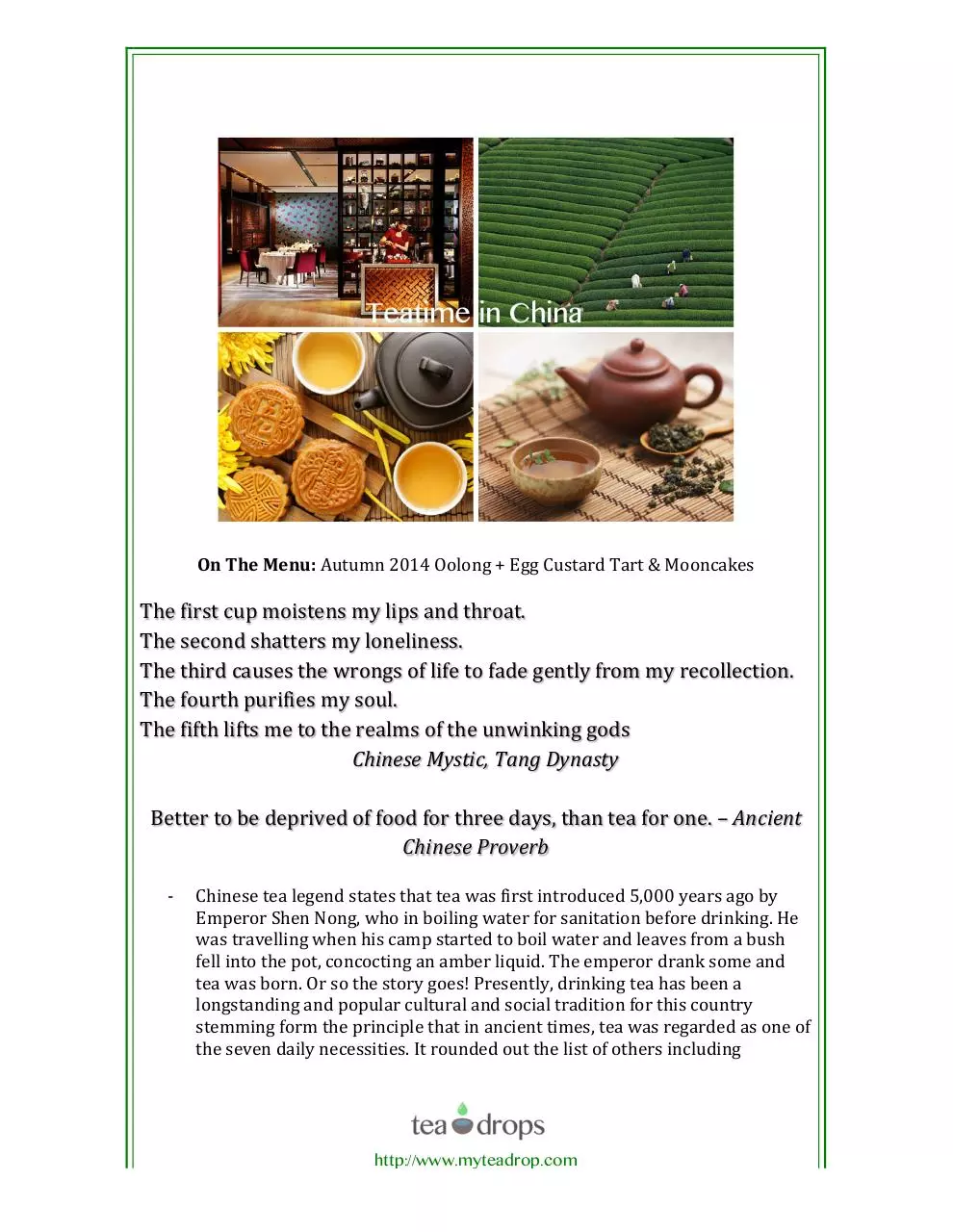TeatimeChina (PDF)
File information
Title: Microsoft Word - TEATIME AROUND THE WORLD - CHINA FINAL.docx
This PDF 1.3 document has been generated by Word / Mac OS X 10.10.3 Quartz PDFContext, and has been sent on pdf-archive.com on 07/05/2015 at 10:15, from IP address 50.131.x.x.
The current document download page has been viewed 925 times.
File size: 708.94 KB (2 pages).
Privacy: public file


File preview
On The Menu: Autumn 2014 Oolong + Egg Custard Tart & Mooncakes
The first cup moistens my lips and throat.
The second shatters my loneliness.
The third causes the wrongs of life to fade gently from my recollection.
The fourth purifies my soul.
The fifth lifts me to the realms of the unwinking gods
Chinese Mystic, Tang Dynasty
Better to be deprived of food for three days, than tea for one. – Ancient
Chinese Proverb
-‐
Chinese tea legend states that tea was first introduced 5,000 years ago by
Emperor Shen Nong, who in boiling water for sanitation before drinking. He
was travelling when his camp started to boil water and leaves from a bush
fell into the pot, concocting an amber liquid. The emperor drank some and
tea was born. Or so the story goes! Presently, drinking tea has been a
longstanding and popular cultural and social tradition for this country
stemming form the principle that in ancient times, tea was regarded as one of
the seven daily necessities. It rounded out the list of others including
http://www.myteadrop.com
-‐
firewood, rice, oil, salt, soy sauce, and vinegar. It was also used for medicinal
purposes and cooking.
Today, tea drinking in China is an incredibly important social gesture. For
instance, it is a common practice for younger generations to pay for their
elders to drink tea at a restaurant or tea house during family gatherings and
holidays. Offering this is a sign of respect. The Chinese have even assimilated
the act of pouring tea as a sign of apology, regret, and submission. Tea is also
a part of Chinese wedding ceremonies where the bride and groom serve tea
to their parents as a sign of gratitude. Since families are commonly rather
extended in Chinese culture, tea during the wedding festivities is also a
chance for the two families to meet (sometimes for the first time) and bond.
Enjoying tea in this way is a sign of acceptance.
-‐
Tea Houses were an incredibly popular destination during the Song, Ming,
and Qing Dynasties as epicenters for social engagement, entertainment, and
leisure. These cafes even outnumbered traditional restaurants due to their
popularity and importance to social life in China. In Hong Kong, elders would
meet at tea houses to connect, read newspapers, and debate as well as
exchange news. In modern times, however, this tradition has begun to die out
with the younger generations seeing old tea places as unhygienic and noisy,
preferring the larger, newer, and more expensive restaurants in which to
enjoy their tea.
China’s Popular Tea Provinces:
Source Image: http://www.thechineseteashop.com/images/tea-‐regions-‐map.gif
Want To Learn More?
The China Tea Book by Luo Jialin
Chinese Tea Culture: The Origin of Drinking Tea by Wang Ling
Hong Kong Apothecary by Simon Go
http://www.myteadrop.com
Download TeatimeChina
TeatimeChina.pdf (PDF, 708.94 KB)
Download PDF
Share this file on social networks
Link to this page
Permanent link
Use the permanent link to the download page to share your document on Facebook, Twitter, LinkedIn, or directly with a contact by e-Mail, Messenger, Whatsapp, Line..
Short link
Use the short link to share your document on Twitter or by text message (SMS)
HTML Code
Copy the following HTML code to share your document on a Website or Blog
QR Code to this page

This file has been shared publicly by a user of PDF Archive.
Document ID: 0000224643.